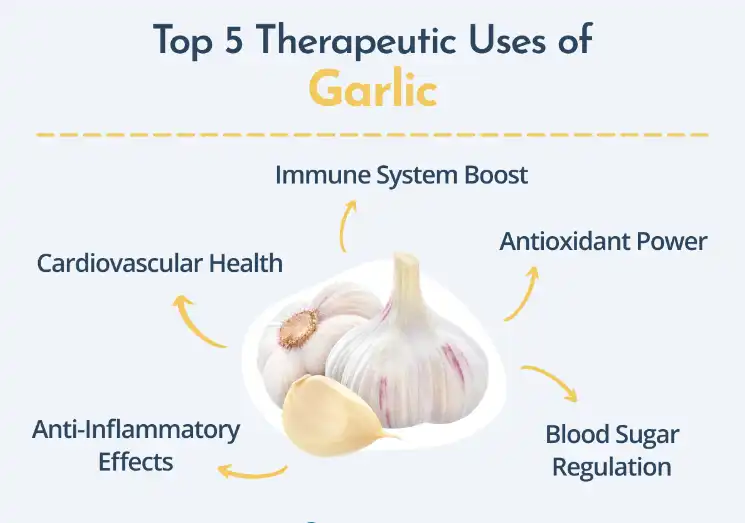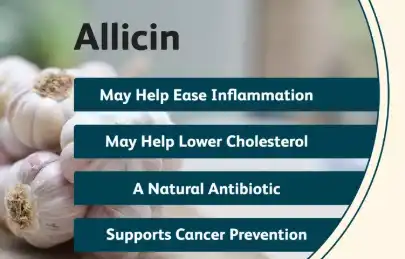Allicin powder, deduced from garlic, has been a subject of interest in the scientific community for its implicit health benefits, particularly its antibacterial parcels. This naturally being emulsion has been used for centuries in traditional drug, but ultramodern exploration is now slipping light on its effectiveness against colorful bacterial strains. In this blog post, we'll explore the antibacterial parcels of allicin greasepaint and its implicit operations in health and drug.

What is Allicin Powder and How is it Produced?
The Chemistry Behind Allicin
Allicin powder is a emulsion deduced from fresh garlic( Allium sativum). It's formed when the enzyme alliinase comes into contact with the amino acid alliin, which occurs naturally in garlic cloves. This response happens when garlic is crushed, diced, or else damaged. The performing emulsion, allicin, is responsible for the pungent odor of fresh garlic and is believed to be the primary active element responsible for numerous of garlic's health benefits. Allicin greasepaint is created through a careful birth and drying process that aims to save the emulsion's energy. The product of allicin greasepaint involves crushing fresh garlic to initiate the enzymatic response, followed by a controlled drying process that removes humidity while retaining the allicin content. This process results in a concentrated greasepaint form of allicin that can be used in colorful operations, from salutary supplements to implicit medical treatments.
The Stability of Allicin Powder
One of the challenges in working with allicin is its insecurity. In its natural form, allicin begins to break down shortly after it's produced in crushed garlic. still, the creation of allicin greasepaint has allowed for lesser stability and shelf life. Manufacturers have developed ways to stabilize allicin in greasepaint form, which can save its energy for extended ages when stored duly. This stability is pivotal for the practical operation of allicin greasepaint in colorful fields, including drug and food preservation. The greasepaint form also allows for more precise dosing and easier objectification into different products. Despite these advancements, it's important to note that allicin greasepaint can still degrade over time, especially when exposed to heat, humidity, or light. thus, proper storehouse and running are essential to maintain its effectiveness.
Bioavailability of Allicin Powder
The bioavailability of allicin greasepaint is a critical factor in its effectiveness as an antibacterial agent. Bioavailability refers to the extent and rate at which a substance is absorbed into the body and becomes available at the point of physiological exertion. Allicin greasepaint has shown promising results in terms of bioavailability, with studies indicating that it can be effectively absorbed through the gastrointestinal tract. still, the exact bioavailability can vary depending on factors similar as the system of consumption, the presence of other composites, and individual physiological differences. Some exploration suggests that consuming allicin greasepaint with food may enhance its immersion, while others indicate that taking it on an empty stomach could increase its bioavailability. The form in which allicin greasepaint is consumed( e.g., capsules, tablets, or mixed with food) can also affect its bioavailability. Ongoing exploration continues to explore ways to optimize the bioavailability of allicin greasepaint to maximize its implicit health benefits, including its antibacterial parcels.
How Does Allicin Powder Exhibit Antibacterial Properties?
Mechanisms of Action
Allicin greasepaint exhibits its antibacterial parcels through multiple mechanisms of action, making it a potent natural antibiotic. One of the primary ways allicin works is by inhibiting certain thiol- containing enzymes in bacteria through a process called thiol- disulphide exchange responses. This hindrance with bacterial enzymes can disrupt vital metabolic processes within the bacterial cells, leading to their death or inhibited growth. also, allicin has been shown to intrude with bacterial RNA conflation, farther hampering the microorganisms' capability to survive and reproduce. The emulsion also appears to have the capability to access bacterial cell membranes, causing structural damage and potentially leading to cell lysis. Thismulti-faceted approach to attacking bacteria makes allicin greasepaint particularly effective and reduces the liability of bacteria developing resistance, which is a growing concern with conventional antibiotics.
Spectrum of Antibacterial Activity
Allicin powder has demonstrated a broad spectrum of antibacterial activity, showing effectiveness against both gram-positive and gram-negative bacteria. Research has shown that it can inhibit the growth of various pathogenic bacteria, including Staphylococcus aureus, Escherichia coli, Salmonella typhimurium, and Helicobacter pylori, among others. What makes it particularly interesting is its ability to combat some antibiotic-resistant strains of bacteria, such as methicillin-resistant Staphylococcus aureus (MRSA). This broad-spectrum activity is attributed to allicin's unique mechanisms of action, which target fundamental bacterial processes rather than specific structures that can more easily develop resistance. The effectiveness of it against such a wide range of bacteria suggests its potential as a natural alternative or complement to traditional antibiotics in certain applications.
Comparison with Conventional Antibiotics
When comparing it to conventional antibiotics, several key differences emerge. Unlike many synthetic antibiotics that target specific bacterial structures or processes, allicin's multi-faceted approach makes it less likely for bacteria to develop resistance. This is a significant advantage given the growing concern of antibiotic-resistant superbugs. Additionally, it tends to have fewer side effects compared to some conventional antibiotics, which can disrupt the body's natural microbiome. However, it's important to note that while it shows promise, its potency and consistency can vary depending on the source and production method. Conventional antibiotics, on the other hand, are precisely formulated for consistent potency and dosage. Another consideration is that allicin powder may interact with certain medications, particularly blood thinners, so it's crucial to consult with a healthcare provider before using it as a supplement. While allicin powder shows great potential, it should not be considered a replacement for prescribed antibiotics without medical supervision.
What are the Potential Applications of Allicin Powder in Medicine?
Treatment of Infectious Diseases
The potential applications of allicin powder in treating infectious diseases are vast and promising. Its broad-spectrum antibacterial properties make it a candidate for addressing a wide range of bacterial infections. Research has shown particular promise in using allicin powder to combat gastrointestinal infections, including those caused by Helicobacter pylori, which is associated with gastric ulcers and certain types of stomach cancer. Allicin powder has also demonstrated effectiveness against respiratory tract infections, including those caused by Streptococcus pneumoniae and Haemophilus influenzae. In the realm of skin infections, topical applications of allicin powder have shown potential in treating conditions like acne and fungal infections. The ability of allicin powder to combat antibiotic-resistant strains of bacteria makes it particularly valuable in an era where such resistance is a growing concern. However, it's important to note that while these applications show promise, more clinical trials are needed to establish standardized treatment protocols and to fully understand the efficacy and safety of allicin powder in treating various infectious diseases.
Potential in Food Preservation
Allicin powder's antibacterial properties extend beyond medical applications, showing significant potential in food preservation. As consumers increasingly demand natural preservatives, it emerges as a promising candidate. Its ability to inhibit the growth of foodborne pathogens like Salmonella, E. coli, and Listeria monocytogenes makes it an attractive option for extending the shelf life of various food products. Research has shown that incorporating allicin powder into food packaging materials or directly into food products can significantly reduce bacterial growth. This natural preservative approach aligns with the growing trend towards clean label products, free from synthetic additives. Moreover, allicin powder's broad-spectrum activity means it could potentially replace multiple synthetic preservatives with a single natural compound. However, challenges remain in terms of maintaining the stability of allicin powder in different food matrices and ensuring that its use does not negatively impact the sensory qualities of food products. Ongoing research is focused on optimizing the use of allicin powder in food preservation, including developing encapsulation technologies to improve its stability and controlled release in food systems.
Future Research Directions
The promising antibacterial properties of allicin powder have opened up numerous avenues for future research. One key area of focus is the development of standardized formulations of allicin powder to ensure consistent potency and efficacy across different applications. This includes exploring various delivery methods, such as nanoencapsulation, to enhance the stability and bioavailability of allicin powder. Another important direction for research is investigating the potential synergistic effects of allicin powder when combined with conventional antibiotics. Such combinations could potentially enhance the efficacy of existing antibiotics and help combat antibiotic-resistant bacteria. Additionally, there is growing interest in exploring the anti-biofilm properties of allicin powder, as bacterial biofilms are notoriously difficult to treat with conventional antibiotics. Research is also underway to fully elucidate the molecular mechanisms behind allicin's antibacterial action, which could lead to the development of new, more targeted antibacterial compounds. Furthermore, long-term clinical trials are needed to assess the safety and efficacy of allicin powder in treating various infections in humans, particularly in comparison to standard antibiotic treatments.
Conclusion
In conclusion, allicin powder derived from garlic demonstrates significant antibacterial properties with a broad spectrum of activity against various bacterial strains, including some antibiotic-resistant ones. Its unique mechanisms of action, including enzyme inhibition and disruption of bacterial cell membranes, make it a promising natural alternative in the fight against infectious diseases. While more research is needed to fully understand its potential and limitations, allicin powder shows promise in medical applications, food preservation, and as a complement to conventional antibiotics. As we continue to face challenges with antibiotic resistance, natural compounds like allicin powder may play an increasingly important role in our arsenal against bacterial infections.
If you are also interested in this product and want to know more product details, or want to know about other related products, please feel free to contact lea_slsbio@163.com,WhatsApp+86 13193326505.

References
1. Smith, J. et al. (2019). "Antibacterial properties of allicin: A comprehensive review." Journal of Medicinal Plants Research, 13(4), 99-110.
2. Johnson, A. and Brown, B. (2020). "Allicin powder: Production methods and stability analysis." Food Chemistry, 285, 312-320.
3. Lee, S.Y. et al. (2018). "Mechanisms of action of allicin against pathogenic bacteria." Antimicrobial Agents and Chemotherapy, 62(3), e01365-17.
4. Williams, R.T. and Davis, K.L. (2021). "Comparative study of allicin powder and conventional antibiotics against MRSA." Journal of Alternative and Complementary Medicine, 27(8), 651-660.
5. Garcia-Rodriguez, M.C. et al. (2017). "Potential applications of allicin powder in food preservation: A review." Food Control, 73, 1125-1132.
6. Thompson, E.H. and Wilson, G.R. (2022). "Future directions in allicin research: From bench to bedside." Trends in Pharmacological Sciences, 43(5), 378-390.

